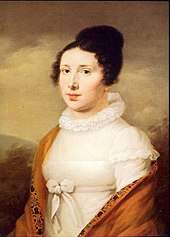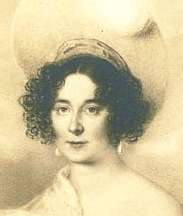Für Elise
| Für Elise | |
|---|---|
| Piano music by Ludwig van Beethoven | |
 The beginning | |
| Key | A minor |
| Catalogue | |
| Composed | 27 April 1810 |
| Published | 1867 |
|
| |
Bagatelle No. 25 in A minor (WoO 59, Bia 515) for solo piano, commonly known as "Für Elise" (German: [fyːɐ̯ ʔeˈliːzə], English: "For Elise"), is one of Ludwig van Beethoven's most popular compositions.[1][2][3] It was not published during his lifetime, only being discovered (by Ludwig Nohl) forty years after his death, and may be termed either a Bagatelle or an Albumblatt. The identity of "Elise" is unknown; researchers have suggested Therese Malfatti, Elisabeth Röckel or Elise Barensfeld.
History

The score was not published until 1867, 40 years after the composer's death in 1827. The discoverer of the piece, Ludwig Nohl, affirmed that the original autographed manuscript, now lost, was dated 27 April 1810.[4] The music was published as part of Nohl's Neue Briefe Beethovens (New letters by Beethoven) on pages 28 to 33, printed in Stuttgart by J. G. Cotta.
The version of "Für Elise" heard today is an earlier version that was transcribed by Ludwig Nohl. There is a later version, with drastic changes to the accompaniment which was transcribed from a later manuscript by the Beethoven scholar Barry Cooper. The most notable difference is in the first theme, the left-hand arpeggios are delayed by a 16th note. There are a few extra bars in the transitional section into the B section; and finally, the rising A minor arpeggio figure is moved later into the piece. The tempo marking Poco moto is believed to have been on the manuscript that Ludwig Nohl transcribed (now lost). The later version includes the marking Molto grazioso. It is believed that Beethoven intended to add the piece to a cycle of bagatelles.[5]
The pianist and musicologist Luca Chiantore argued in his thesis and his 2010 book Beethoven al piano (new Italian edition: Beethoven al pianoforte, 2014) that Beethoven might not have been the person who gave the piece the form that we know today. Chiantore suggested that the original signed manuscript, upon which Ludwig Nohl claimed to base his transcription, may never have existed.[6] On the other hand, Barry Cooper wrote, in a 1984 essay in The Musical Times, that one of two surviving sketches closely resembles the published version.[7]
Identity of "Elise"


It is not certain who "Elise" was. Max Unger suggested that Ludwig Nohl may have transcribed the title incorrectly and the original work may have been named "Für Therese",[8] a reference to Therese Malfatti von Rohrenbach zu Dezza (1792–1851). She was a friend and student of Beethoven's to whom he supposedly proposed in 1810, though she turned him down to marry the Austrian nobleman and state official Wilhelm von Droßdik in 1816.[9] Note that the piano sonata no. 24, dedicated to Countess Thérèse von Brunswick, is also referred to sometimes as "für Therese". The Austrian musicologist Michael Lorenz[10] has shown that Rudolf Schachner, who in 1851 inherited Therese von Droßdik's musical scores, was the son of Babette Bredl, born out of wedlock. Babette in 1865 let Nohl copy the autograph in her possession.
According to a 2010 study by Klaus Martin Kopitz, there is evidence that the piece was written for the German soprano singer Elisabeth Röckel (1793–1883), later the wife of Johann Nepomuk Hummel. "Elise", as she was called by a parish priest (she called herself "Betty" too), had been a friend of Beethoven's since 1808.[11] In 2015 Kopitz published further sources about Beethoven's relationship to Elisabeth and the famous piano piece. It shows that she was also a close friend of Anna Milder-Hauptmann and lived together with her in the Theater an der Wien. The singer was the first who played the title role of Beethoven's opera Fidelio. In a letter to Elisabeth she called her indeed "Elise".[12]
In 2014, the Canadian musicologist Rita Steblin suggested that Elise Barensfeld might be the dedicatee. Born in Regensburg and treated for a while as a child prodigy, she first travelled on concert tours with Beethoven's friend Johann Nepomuk Mälzel, also from Regensburg, and then lived with him for some time in Vienna, where she received singing lessons from Antonio Salieri. Steblin argues that Beethoven dedicated this work to the 13-year-old Elise Barensfeld as a favour to Therese Malfatti who lived opposite Mälzel's and Barensfeld's residence and who might have given her piano lessons.[13] Steblin admits that question marks remain for her hypothesis.[14]
Music
The piece is basically in rondo form, ABACA. It is in A minor and in 3
8 time. It begins with an A minor theme marked Poco moto (in some motion), with the left hand playing arpeggios alternating between A minor and E major. The same motifs follow around C major and G major, before returning to the original theme. The B section in the submediant major of F major which concludes in 32nd note runs leading to a repeat of the A section. In the C section, an agitated theme in the subdominant key of D minor is accompanied by repetitive chords on a pedal point, with some dramatic diminished seventh chords. This section concludes with an ascending A minor arpeggio followed by a chromatic descent over two octaves, leading to another repeat of the A section. While the A section is not difficult to play, the runs in the B section and the rapid rising figure in the C section require more pianistic skill.
Kopitz presents the finding by the German organ scholar Johannes Quack that the letters that spell Elise can be decoded as the first three notes of the piece. Because an E♭ is called an Es in German and is pronounced as "S", that makes E–(L)–(I)–S–E: E–(L)–(I)–E♭–E, which by enharmonic equivalents sounds the same as the written notes E–(L)–(I)–D♯–E.[10][15]
References
- ↑ William Kinderman, The Cambridge Companion to Beethoven, Cambridge: Cambridge University Press, 2000, pp. 125–126, ISBN 978-0-521-58934-5
- ↑ Dorothy de Val, The Cambridge Companion to the piano, Cambridge: Cambridge University Press, 1998, p. 131, ISBN 978-0-521-47986-8, "Beethoven is here [in the 1892 Repertory of select pianoforte works] only by virtue of 'Für Elise', but there is a better representation of later composers such as Schubert ... , Chopin ... , Schumann ... and some Liszt."
- ↑ Morton Manus, Alfred's Basic Adult All-In-One Piano Course, Book 3, New York: Alfred publishing, p. 132, ISBN 978-0-7390-0068-7
- ↑ Fuld, James J. (20 March 2000). The Book of World-famous Music: Classical, Popular, and Folk. Courier Dover Publications. p. 241. ISBN 978-0-486-41475-1. Retrieved 25 April 2011.
- ↑ Ludwig van Beethoven, Klavierstück a-Moll WoO 59 "Für Elise". Kritische Ausgabe mit Faksimile der Handschrift BH 116, Skizzentranskription und Kommentar. Sieghard Brandenburg, Bonn 2002, pp. 8 and 15
- ↑ Luca Chiantore: Beethoven al piano. Barcelona: Nortesur, 2010, p. 333–360, ISBN 978-84-937357-6-0
- ↑ "Who Wrote "Für Elise"?". The New Yorker. 16 October 2009.
- ↑ Max Unger, translated by Theodore Baker, "Beethoven and Therese von Malfatti," The Musical Quarterly 11, no. 1 (1925): 63–72.
- ↑ Michael Lorenz: "Baronin Droßdik und die verschneyten Nachtigallen. Biographische Anmerkungen zu einem Schubert-Dokument", Schubert durch die Brille 26, (Tutzing: Schneider, 2001), pp. 47–88.
- 1 2 Michael Lorenz: "'Die enttarnte Elise'. Die kurze Karriere der Elisabeth Röckel als Beethovens 'Elise'", Bonner Beethoven-Studien vol. 9, (Bonn 2011), 169–90.
- ↑ Klaus Martin Kopitz: Beethoven, Elisabeth Röckel und das Albumblatt "Für Elise", Köln: Dohr, 2010, ISBN 978-3-936655-87-2.
- ↑ Klaus Martin Kopitz: Beethovens "Elise" Elisabeth Röckel. Neue Aspekte zur Entstehung und Überlieferung des Klavierstücks WoO 59, Die Tonkunst, vol. 9, no. 1 (January 2015), pp. 48–57 (PDF)
- ↑ "War Mälzels Sängerin auch Beethovens 'Elise'?" by Juan Martin Koch, Neue Musikzeitung, 15 November 2012 (in German)
- ↑ "Geheimnis um Beethovens 'Elise' gelüftet?", Die Welt, 16 November 2012 (in German); Steblin, Rita: "Who was Beethoven’s 'Elise'? A new solution to the mystery." In: The Musical Times 155 (2014), pp. 3-39
- ↑ Kopitz 2010, pp. 50f
External links
| Wikimedia Commons has media related to Für Elise. |
- "Für Elise": Scores at the International Music Score Library Project (IMSLP)
- "Für Elise" at the Mutopia Project
- "Für Elise" performed by Beau Pluto
- Free sheet music of "Für Elise" from Cantorion.org
- "Für Elise", for piano and orchestra on YouTube, arranged by Georgii Cherkin
- Nohl's first publication of "Für Elise" in 1867
- "Für Elise" sheet music, and free recording by Valentina Lisitsa
- A MIDI of the revised version Beethoven was working on in 1822
- Michael Lorenz: "Maria Eva Hummel. A Postscript", Vienna 2013
- Michael Lorenz: "A Letter to the Editor of The Musical Times", Vienna 2014